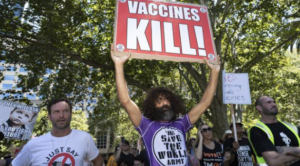Home » Commentary » Opinion » No dancing past the fact we’ll have to live with Covid
· The Australian

 As COVID-19 trudges through endless revisions of rules and regulations, Australia’s response to the virus is beginning to resemble the blackest of farces.
As COVID-19 trudges through endless revisions of rules and regulations, Australia’s response to the virus is beginning to resemble the blackest of farces.
State premiers, untethered from parliamentary democracy, are free to issue decrees based on their impenetrable divinations. In Queensland, wedding guests may dance “subject to one person per 2sq m”. In Victoria, the regulation requires “one person per 4sq m”. I am not sure exactly which dances are performed at such a decorous distance, but it is probably safe to say the tango would be frowned upon in Victoria.
Midway through his most recent lockdown, West Australian Premier Mark McGowan decreed diners must wear masks in Perth restaurants. When asked how this could work, he replied: “Use your common sense.” Good advice. Too bad there is so little common sense around.
Indeed, common sense has never been very common. In its early decades, Australia faced the bubonic plague. As now, governments prohibited free movement. As it transpired, the rats and fleas spreading bubonic plague were indifferent to the edicts of politicians. The COVID-19 virus may well hold a similar disdain for dancing at a distance.
Common sense begins with proportionality. On average, three Australians die in road accidents every day. The World Health Organisation has found that speed predicts motor car accidents. A speed increase of one kilometre an hour results in a 3 per cent higher risk of a crash involving injury, with a 4-5 per cent increase for collisions that result in fatalities. If governments lowered the nation’s speed limit to 10km an hour, the highway death toll would fall to zero.
Absurd, you might think. Crawling around at 10km an hour would not only be frustrating and tedious, but it would also be very costly — to commerce, tourism, and work productivity. As a society, we have chosen a compromise. We are willing to sacrifice more than 1000 lives a year so that we can drive faster. We pay the price in blood on our highways.
Is there room for similar proportionality in the way we deal with COVID-19? At present, premiers take actions designed to reduce illness almost to zero, but lockdowns, border closures and other regulations come with costs. The damages are not just economic. Having a job, dancing at a wedding, witnessing your child’s birth — these are not optional extras to life. They are what makes life worth living.
So far, there is no sign of a Eureka Stockade rebellion. (As Clive James once reminded us, we are not only the descendants of convicts but also of prison officers.) Public attitudes may change once people understand what an immunisation program can, and cannot, achieve.
The only human infectious disease ever eradicated by a vaccination program is smallpox; it took 200 years. Eliminating COVID-19 from Australia is an achievable objective, but elimination also takes a long time. Australia was officially declared free of polio in 2000 — 40 years after the vaccination program began.
As everyone knows by now, ridding Australia of COVID-19 depends on the country achieving herd immunity. But herd immunity is not a treatment; it is a statistical concept. Once a certain proportion of the population (the herd) is immune to a disease — thanks to a vaccine or as a result of recovering from the virus itself — infection rates decline because the disease is unable to find susceptible hosts. The existence of an effective vaccine is only the first step on the road to herd immunity. We must also ensure a sufficient number of people are vaccinated and receive booster shots when necessary. Neither of these requirements is swiftly met. Vaccines effective against whooping cough have been available since the 1930s, yet thousands of Australians contract the disease every year. Many suffer severe consequences.
Even if we successfully eliminate COVID-19 through herd immunity, we cannot assume no Australian will ever again catch it. According to the WHO, Australia “eliminated” measles in 2014, yet cases have been reported in Australia every year since.
The reason for measles persistence is its continued existence in other countries. Visitors and unvaccinated Australian travellers contract the illness while abroad. When they enter Australia, they spread the disease to those who refuse vaccines and those unable to be immunised because of age or poor immune functioning. A neighbourhood with a low vaccination rate is like a cache of dynamite just waiting for an infected traveller to detonate an explosion.
No state government quarantines Australians returning home from countries with measles outbreaks. This insouciance about a highly contagious and dangerous disease is difficult to reconcile with the draconian approach taken to COVID-19.
Unfortunately, this virus will be with us for years. Let us hope our leaders begin to consider trade-offs. If they stick to their current course, quarantines, lockdowns and border closures may go on forever.
Emeritus Professor Steven Schwartz is a Senior Fellow at the Centre for Independent Studies, former vice-chancellor of Macquarie, Murdoch and Brunel universities, and former executive dean of Medicine and Dentistry at the University of Western Australia.
No dancing past the fact we’ll have to live with Covid